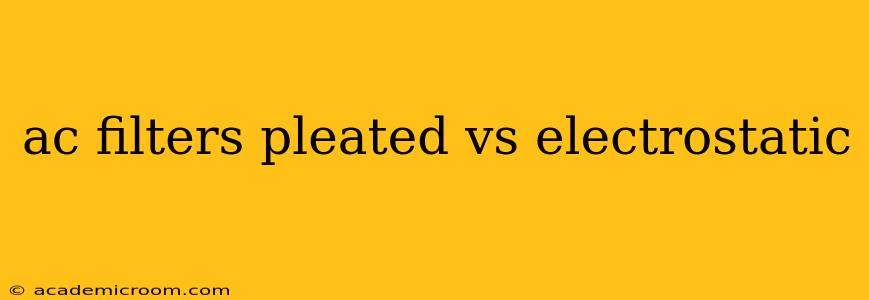Choosing the right air conditioner filter can significantly impact your indoor air quality and the efficiency of your HVAC system. Two popular types are pleated and electrostatic filters. Understanding their differences is crucial for making an informed decision. This comprehensive guide will delve into the specifics of each, helping you determine which best suits your needs.
What are Pleated AC Filters?
Pleated air filters are the most common type found in homes. They consist of a pleated, fibrous material, usually made of fiberglass or synthetic materials, arranged within a frame. The pleats increase the surface area available to trap airborne particles. This design allows for more efficient filtration compared to a flat panel filter of the same size.
Advantages of Pleated Filters:
- Higher efficiency: The increased surface area allows for better particle capture, improving indoor air quality.
- Longer lifespan: They generally last longer than electrostatic filters before needing replacement.
- Widely available: Easily found at most home improvement stores and online retailers.
- Cost-effective: Generally less expensive than electrostatic filters, particularly the higher-rated MERV filters.
Disadvantages of Pleated Filters:
- Can restrict airflow: High-efficiency pleated filters (like those with a high MERV rating) can sometimes restrict airflow, potentially reducing the efficiency of your HVAC system. This may require more frequent filter changes, offsetting some of the cost savings.
- Not suitable for all allergies: While effective for many particles, they might not capture all allergens, particularly smaller ones.
What are Electrostatic AC Filters?
Electrostatic air filters utilize static electricity to attract and trap airborne particles. They are often made of a charged mesh or fiber material. The electrostatic charge creates an attractive force for dust, pollen, and other contaminants, effectively removing them from the air.
Advantages of Electrostatic Filters:
- Low resistance to airflow: These filters generally offer less resistance to airflow compared to high-efficiency pleated filters, leading to improved HVAC system efficiency.
- Effective at trapping smaller particles: They can capture smaller particles than some pleated filters, making them beneficial for those with severe allergies.
- Washable and reusable: Many electrostatic filters are washable and reusable, reducing waste and long-term costs.
Disadvantages of Electrostatic Filters:
- Shorter lifespan (if washable): While reusable, they may lose effectiveness over time and need frequent cleaning or replacement.
- Can be less efficient: While effective at trapping some particles, they may not be as effective as higher-MERV pleated filters at capturing larger particles.
- Requires proper cleaning: Improper cleaning can reduce their effectiveness.
Pleated vs. Electrostatic: Which is Better?
The "better" filter depends entirely on your individual needs and priorities.
- For those prioritizing cost and ease of replacement: Pleated filters are a good option. A standard pleated filter is a low-cost, readily-available solution.
- For those with severe allergies or sensitivities: Electrostatic filters might be preferable due to their ability to capture smaller particles. However, regular cleaning is crucial to maintain their effectiveness.
- For those seeking maximum efficiency and minimal airflow restriction: A medium-efficiency pleated filter might strike the best balance. High-MERV pleated filters offer high filtration but can restrict airflow, while low-MERV pleated filters may not provide adequate filtration. Electrostatic filters often represent a good compromise between efficiency and airflow.
How Often Should You Change Your AC Filter?
The frequency of filter replacement depends on several factors, including the type of filter, the size of your home, the number of occupants, and the presence of pets. Generally, pleated filters need changing every 1-3 months, while the lifespan of reusable electrostatic filters varies greatly based on usage and cleaning. Always refer to the manufacturer's recommendations.
What MERV rating should I use?
MERV (Minimum Efficiency Reporting Value) ratings indicate a filter's effectiveness in removing particles from the air. Higher MERV ratings mean greater efficiency but also greater airflow restriction. The optimal MERV rating depends on your specific needs and HVAC system. Consult with an HVAC professional to determine the appropriate MERV rating for your system.
Can I wash electrostatic air filters?
Yes, many electrostatic filters are washable, adding to their cost-effectiveness and reducing waste. However, always check the manufacturer's instructions for specific cleaning guidelines. Improper cleaning can damage the filter and reduce its effectiveness.
Choosing the right AC filter is a vital step in maintaining a healthy and comfortable indoor environment. By weighing the advantages and disadvantages of pleated and electrostatic filters, you can make the best decision for your home and family. Remember to consult with an HVAC professional for tailored advice based on your specific needs and system requirements.
